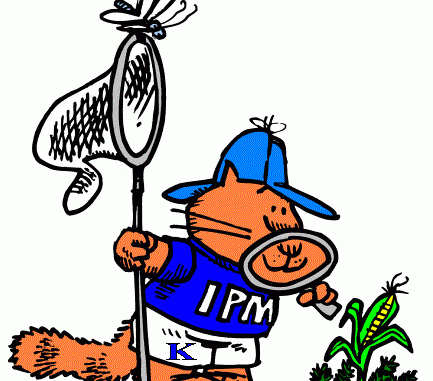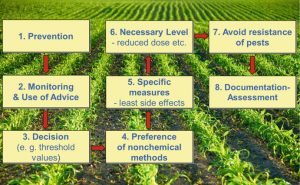
Table of Contents
What are Pests?
- Pests are usually defined as the insects or other animals that attacks the crops and destroys the cultivation
- Usually, lots of chemicals or pesticides are used to get rid of them
- However, the problem still continues and use of pesticides further leads to other gigantic problems.
What is Integrated Pest Management (IPM)?
- Integrated Pest Management (IPM) is an ecosystem-based strategy that focuses on long-term prevention of pests or their damage through a combination of techniques such as biological control, habitat manipulation, modification of cultural practices, and use of resistant varieties.
- It is an approach to control the pest in an integrated way.
- Under this method, pesticides are only used according to standard established guidelines and treatment is done with a goal of removing only the target organisms.
- It is a method which is used to solve pest problems without or at low level of risk to the people and the environment.
- It is an eco-friendly method of pest control.
- Furthermore, IPM can also be considered as a pest control program that combines several methods for prevention from the pest and protection of the plants.
- IPM incorporates several biological, ecological, physical and chemical strategies for controlling the pests’ problems
- IPM programs use information on the life cycles of pests and their interaction with the environment. This information is then used to manage pest damage.
Principles of IPM:
Principle 1: Prevention and Suppression
- Prevention is adoption of measures to reduce the chance of occurrence of pest. Suppression is reducing the impact of the pests.
- Prevention and suppression can be done by applying the different techniques.
- It is a method of preventing the spreading of harmful organisms by hygiene measures (e.g. by regular cleansing of machinery and equipment)
- One of the methods of prevention and suppression is crop rotation where it would break the life cycle of the pests.
- Prevention and suppression also include use of adequate cultivation techniques (e.g. stale seedbed technique, sowing dates and densities, under-sowing, conservation tillage, pruning and direct sowing)
Principle 2: Monitoring
- Harmful organisms must be monitored by adequate methods and tools, wherever available.
- Monitoring can be done through observations, use of scientifically sound warning, forecasting and early diagnosis systems, advice from professionally qualified advisers, etc.
- Many countries like France, Denmark have adopted this monitoring and forecasting technique
Principle 3: Decision making
- Decision making is done based on the results of the monitoring
- IPM focuses on threshold-based intervention in most of the cases. Threshold is the defined pest density, or population level, which when exceeded, management should occur.
- However, threshold is difficult to define in most of the cases and in case of tolerant species, decision of intervention is based on the general observations.
- We should also be aware that specific crops, pest life cycle, climatic condition, etc., should be considered before making any kind of decisions
Principle 4: Non-Chemical Methods
- Non-chemical methods are prioritized over chemical methods if they can produce satisfactory results.
- As chemical methods are often not sustainable and creates more pest problems, non-chemical methods are always preferred at first hand as they are more sustainable with less biological and environmental hazards.
- Examples of non-chemical methods include soil-solarization or biological control.
- Use of live natural enemies is one of the major non-chemical (biological) intervention method
- Other non-chemical methods include biological, physical and ecological methods.
Principle 5: Pesticide Selection
- IPM doesn’t totally avoid the use of the pesticides
- When the alternative methods are not properly used then the pesticides are used for pest control.
- The pesticides used however needs to be as specific as possible for the target
- The pesticides shouldn’t possess any threat to the health of human, non-target humans and environment.
Principle 6: Reduced Pesticide Use
- Reduced pesticides use refers to the reduction in the frequency and doses of the pesticides
- This method needs to be supported by the other means of intervention
- It helps in reducing the side effects of the pesticides
Principle 7: Anti- resistant Strategies
- IPM focuses on the anti-resistance activities as:
- Unmanaged and haphazard use of the pesticides have created the problem of resistance and
- Pests have developed the resistance and the use of pesticides have less effect on them
- This is also the major reason for the IPM.
- Anti-resistant strategies include use of combination of different pesticides that has different mode of action, applied in different time.
Principle 8: Evaluation
- Evaluation is the important aspect of the IPM program.
- Evaluation is done based on the records of the use of the pesticides, its effects and many more.
- Evaluation is necessary in studying the effectiveness of the plan protective measures and plan further.
Advantages of IPM:
1. Lower cost intervention
- Traditionally, the use of the pesticides to control the pest invasion would account to lots of cost.
- Also, these pesticides need to be imported as well
- The application of IPM would lessen the financial burden.
- Moreover, different techniques involved in IPM are more sustainable with long lasting benefits
2. Benefits to the environment
- Use of the pesticides are often linked degradation of the environment causing some more additional problems
- IPM is an eco-friendly approach and the effects on the environment is always considered before the application of any interventions
- Less use of pesticides won’t affect the fertility of soil
3. Minimizes residue hazards of pesticides
- It is obvious that in an IPM schedule the use of pesticides will be considerably reduced, hence the pesticide residue hazards will also get automatically minimized.
4. Anti-Resistance
- The IPM model in itself is the anti-resistant mode for pest control.
- It discourages the use of chemicals and thus creates less cases of anti-resistance.
- Pesticides are used only when the other alternatives are not satisfying.
5. Useful and best intervention for the general public
- Assurance of safe, reliable and low-cost pest control
- The pest control will not affect the crops
- Moreover, it is safe and affordable for the general public as well
Disadvantages or limitations of IPM:
1. More involvement in the technicalities of the method
- IPM needs to be planned
- IPM demands more attention and dedication
- Requires expertise of various field
- All those involved in the IPM needs to be educated and trained which often requires much time.
2. Time and energy consuming
- Application of IPM takes time.
- Much time is needed in planning itself.
- As IPM strategies differs from region to region, a separate plan is required for each region.
- The expected results of intervention may take long time to be achieved.
Challenges in IPM:
- Financial constraints in initiation of the IPM
- Lack of involvement of the expertise
- Inadequate research on pests
- Lack of supportive government and policies
- In developing countries where traditional farming is still practiced, farmers are unknown to the concept of IPM as well as IPM seems difficult to practice.
References and for More Information:
https://www.epa.gov/managing-pests-schools/introduction-integrated-pest-management
https://www.maximumyield.com/definition/539/integrated-pest-management-ipm
https://link.springer.com/article/10.1007/s13593-015-0327-9
https://www.nrdnet.org/sites/default/files/integrated_pest_management.pdf
https://iapps2010.me/2016/01/19/european-unions-eight-principles-of-integrated-pest-management-ipm/
https://link.springer.com/article/10.1007/s13593-015-0327-9#Sec6
https://www.unce.unr.edu/programs/sites/ipm/principles/
http://niphm.gov.in/Recruitments/ASO-Pathology.pdf
http://www.tpma.org/_organizational/ipm_benefits.htm
https://greentumble.com/advantages-and-disadvantages-of-integrated-pest-management/
http://www.extento.hawaii.edu/IPM/othersites/lessontw.htm
https://integratedpestmanagement.weebly.com/advantages-and-disadvantages.html
https://www.ncbi.nlm.nih.gov/pmc/articles/PMC3956194/
https://www.researchgate.net/publication/269333256_Integrated_Pest_Management_in_Nepal
https://www2.ipm.ucanr.edu/What-is-IPM/
https://www.epa.gov/safepestcontrol/integrated-pest-management-ipm-principles
https://www.unce.unr.edu/programs/sites/ipm/principles/
